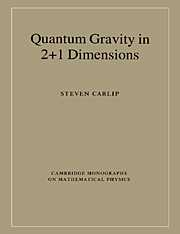Book contents
- Frontmatter
- Contents
- Preface
- 1 Why (2+1)-dimensional gravity?
- 2 Classical general relativity in 2+1 dimensions
- 3 A field guide to the (2+1)-dimensional spacetimes
- 4 Geometric structures and Chern–Simons theory
- 5 Canonical quantization in reduced phase space
- 6 The connection representation
- 7 Operator algebras and loops
- 8 The Wheeler–DeWitt equation
- 9 Lorentzian path integrals
- 10 Euclidean path integrals and quantum cosmology
- 11 Lattice methods
- 12 The (2+1)-dimensional black hole
- 13 Next steps
- Appendix A The topology of manifolds
- Appendix B Lorentzian metrics and causal structure
- Appendix C Differential geometry and fiber bundles
- References
- Index
1 - Why (2+1)-dimensional gravity?
Published online by Cambridge University Press: 15 December 2009
- Frontmatter
- Contents
- Preface
- 1 Why (2+1)-dimensional gravity?
- 2 Classical general relativity in 2+1 dimensions
- 3 A field guide to the (2+1)-dimensional spacetimes
- 4 Geometric structures and Chern–Simons theory
- 5 Canonical quantization in reduced phase space
- 6 The connection representation
- 7 Operator algebras and loops
- 8 The Wheeler–DeWitt equation
- 9 Lorentzian path integrals
- 10 Euclidean path integrals and quantum cosmology
- 11 Lattice methods
- 12 The (2+1)-dimensional black hole
- 13 Next steps
- Appendix A The topology of manifolds
- Appendix B Lorentzian metrics and causal structure
- Appendix C Differential geometry and fiber bundles
- References
- Index
Summary
The past 25 years have witnessed remarkable growth in our understanding of fundamental physics. The Weinberg–Salam model has successfully unified electromagnetism and the weak interactions, and quantum chromodynamics (QCD) has proven to be an extraordinarily accurate model for the strong interactions. While we do not yet have a viable grand unified theory uniting the strong and electroweak interactions, such a unification no longer seems impossibly distant. At the phenomenological level, the combination of the Weinberg–Salam model and QCD – the Standard Model of elementary particle physics – has been spectacularly successful, explaining experimental results ranging from particle decay rates to high energy scattering cross-sections and even predicting the properties of new elementary particles.
These successes have a common starting point, perturbative quantum field theory. Alone among our theories of fundamental physics, general relativity stands outside this framework. Attempts to reconcile quantum theory and general relativity date back to the 1930s, but despite decades of hard work, no one has yet succeeded in formulating a complete, self-consistent quantum theory of gravity. The task of quantizing general relativity remains one of the outstanding problems of theoretical physics.
The obstacles to quantizing gravity are in part technical. General relativity is a complicated nonlinear theory, and one should expect it to be more difficult than, say, electrodynamics. Moreover, viewed as an ordinary field theory, general relativity has a coupling constant G1/2 with dimensions of an inverse mass, and standard power-counting arguments – confirmed by explicit computations – indicate that the theory is nonrenormalizable, that is, that the perturbative quantum theory involves an infinite number of undetermined coupling constants.
- Type
- Chapter
- Information
- Quantum Gravity in 2+1 Dimensions , pp. 1 - 8Publisher: Cambridge University PressPrint publication year: 1998
- 3
- Cited by

